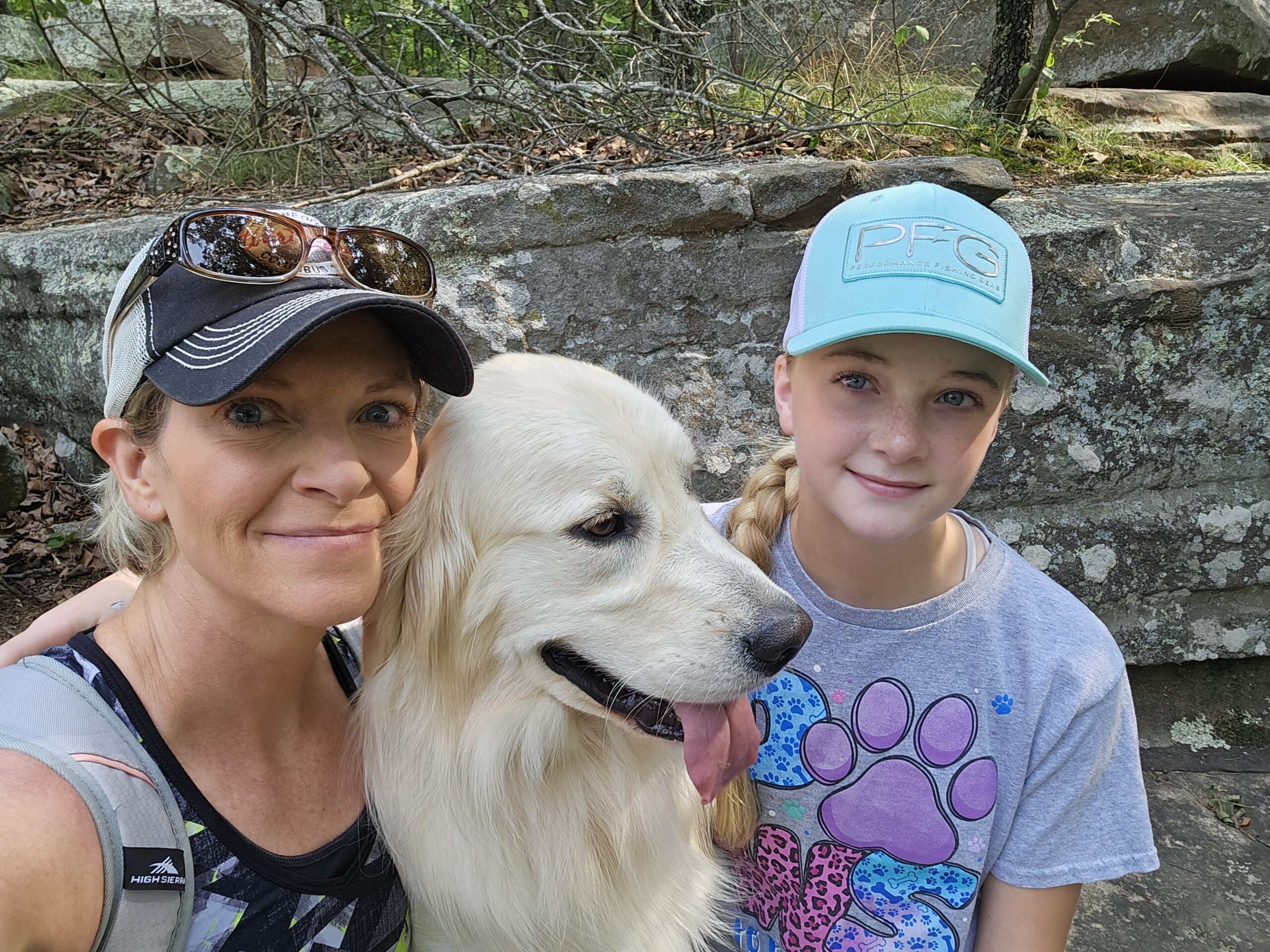Being active with your pet is not just about keeping them physically healthy; it is about fostering a deep and meaningful relationship. Just like people, pets thrive on companionship, and regular activity combined with love and attention strengthens your bond in ways you may not even realize. Engaging with your pet physically and emotionally brings out their unique personality, nurtures their well-being, and creates a partnership beyond simple pet ownership.
Being Active with Your Pet to Keep Them Physically Well
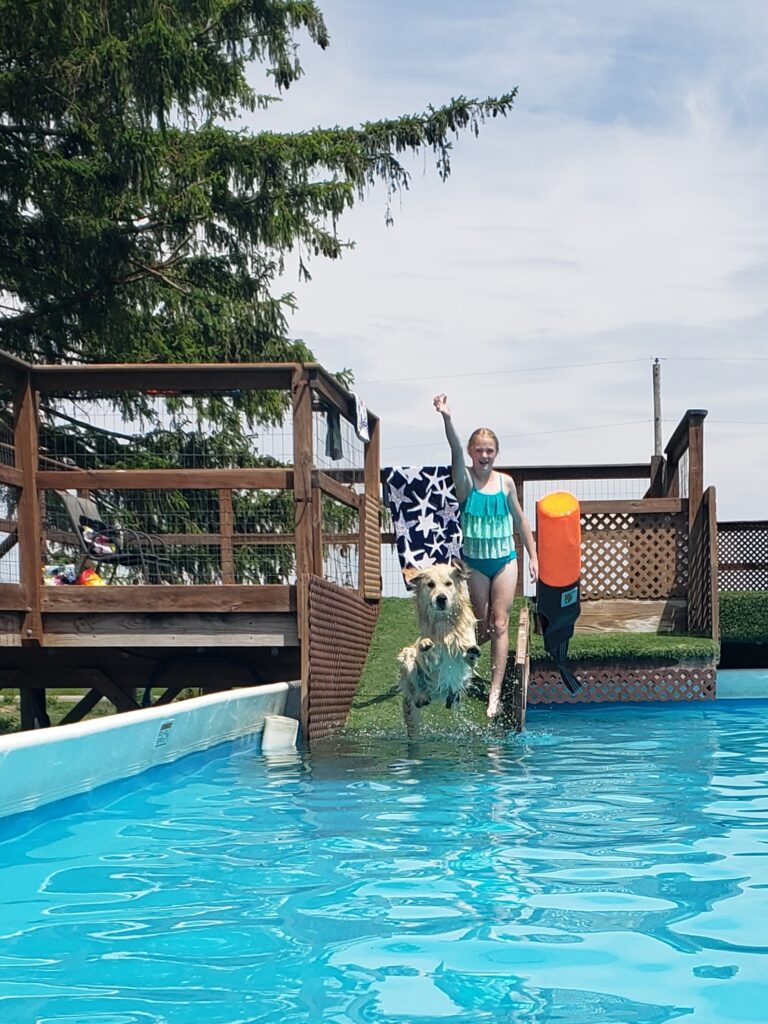
Swimming and playing fetch with Sam, one of his favorite games.
We all know that pets need exercise, but the benefits go beyond what we may think. Just like humans, physically active pets are healthier and more resilient. A sedentary lifestyle can lead to weight gain, joint problems, heart disease, and even diabetes in animals. Regular activity, such as daily walks, play sessions, or even agility training, keeps your pet’s muscles strong, joints flexible, and mind sharp.
Being Active with Your Pet Provides Them Mental Stimulation

Nacho is embracing his golden years, enjoying peaceful fishing trips with his dad.
Exercise is not only about your pet’s physical health; it is also essential for your pet’s mental health. Pets need stimulation to prevent boredom and destructive behavior. When we do not keep our pets mentally stimulated, they can develop anxiety or behavioral problems like barking, chewing, or becoming aggressive. Bored cats have been known to claw furniture, knock things off counters, tear up toilet paper rolls, eliminate outside the litter box, and engage in other unwanted behavior.
Engaging with them through active play, puzzle toys, or new adventures tires pets out physically and keeps their minds engaged. Mental stimulation is essential to a happy, well-rounded pet. For cats, mental stimulation might look different. Activities such as interactive play with toys, climbing structures, or even puzzle feeders mimic their natural hunting instincts and prevent them from becoming too sedentary.
Bringing Out Your Pet’s True Personality
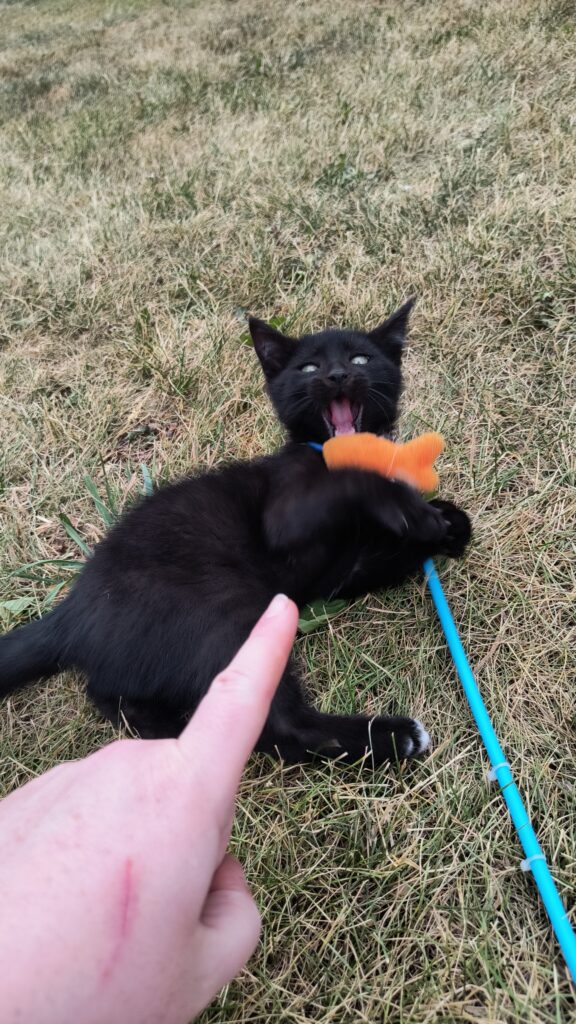
Burning off some kitten energy with a fun wand toy session!
One of the most rewarding parts of being active with your pet is watching their personality bloom. Pets, like humans, thrive on affection and attention, and their emotional health is as important as their physical well-being. People increasingly recognize that pets experience a range of emotions similar to ours—happiness, affection, fear, and even grief or loss.
When you play and engage with your pet, you give them the love and attention they need to feel safe and secure. As a result, they’ll feel more comfortable expressing their true personality, whether it’s through playful antics, a strong loyalty toward you, or an affectionate nuzzle. Some pets may be shy or anxious initially, but with patience, love, and regular interaction, they will begin to trust you and show more of their unique character.
This emotional connection is vital for their overall happiness. A loved and secure pet will be more playful, responsive, and confident. Whether through gentle petting, playing fetch, or just sitting together on the couch, your pet will develop a strong bond with you as they come to see you as their source of comfort, affection, and fun
How You Benefit by Staying Active with Your Pets
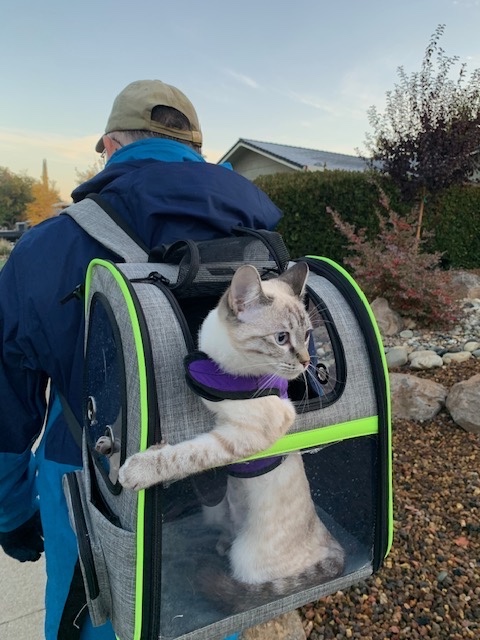
Taking Coco out for a backpack adventure—she loves her outdoor walks!
Staying active with your pet isn’t just beneficial for them—it’s also a fantastic way to improve your own well-being. Engaging in regular physical activity alongside your furry friend can lead to significant health benefits for pet parents, including lower heart rate and reduced stress levels. Physical exercise helps to release endorphins, which can boost your mood and energy levels, while also supporting cardiovascular health. Moreover, the social interaction and bonding time with your pet contribute to a greater sense of happiness and mental well-being. In essence, being active with your pet offers a win-win situation: your pet enjoys a healthier, more stimulating lifestyle, and you get to reap the rewards of improved physical and emotional health.
If you have cats, a great way to include them in your adventures is by training them to walk with a harness and leash or bringing them along in a cat backpack— or both! You can find lots of videos on how to gradually train them to become your walking partner.
Ref:American Heart Association Pet Ownership and Cardiovascular Health
CDC Benefits of Pets for Mental Health
National Institute of Health Pet Ownership and Cardiovascular Health in the U.S.
Understanding Your Pet’s Emotions by Being Active with Your Pet
As more research comes out about animal behavior, we are learning just how complex their emotions are. Pets are not just companions—they are family members with emotional needs like us.
Dogs, for instance, are known for their ability to experience joy, sadness, and even empathy. Studies have shown that dogs can pick up on their owner’s emotions, mirroring feelings of stress or calm. While every pet has a unique personality, here are some ways dogs and cats communicate with us:
Canine Buddies

Exploring the outdoors with Nioh brings out his adventurous spirit—being active with his pet parents lets his personality shine!
- Tail wagging: A wagging tail can indicate happiness, excitement, or anticipation, but the speed and position of the wag can reveal other emotions, such as nervousness or insecurity.
- Body posture: A relaxed body often signals comfort, while a stiff or tense posture may indicate fear or aggression.
- Facial expressions: Dogs can raise their eyebrows, open or close their mouths, or soften their eyes to express joy, curiosity, or calmness. Conversely, a furrowed brow or tightly closed mouth may show stress or unease.
- Ear position: Ears held up and forward can signal interest or alertness, while ears flattened back may show fear or submission.
- Vocalizations: Barking, whining, growling, and howling all convey different emotional states, ranging from excitement and playfulness to fear or warning.
- Yawning: Dogs may yawn when they are tired, but they also yawn as a sign of stress or anxiety. It’s a calming signal dogs use to relieve tension, both for themselves and to communicate to other dogs or humans that they are uncomfortable or anxious in a situation.
- Lip Licking: This behavior can occur when a dog is stressed, anxious, or feeling uncomfortable. If a dog is not eating but repeatedly licks its lips, it can be a sign they are trying to calm themselves or signal to others that they feel uneasy.
- Rolling over or exposing belly: This is often a sign of submission or trust, though it can sometimes be an invitation to play.
- Pawing or nudging: Dogs may paw at you or nudge with their nose to seek attention, affection, or reassurance.
- Hiding or avoiding eye contact: These behaviors often show fear, anxiety, or discomfort, especially in stressful situations.
Feline Companions
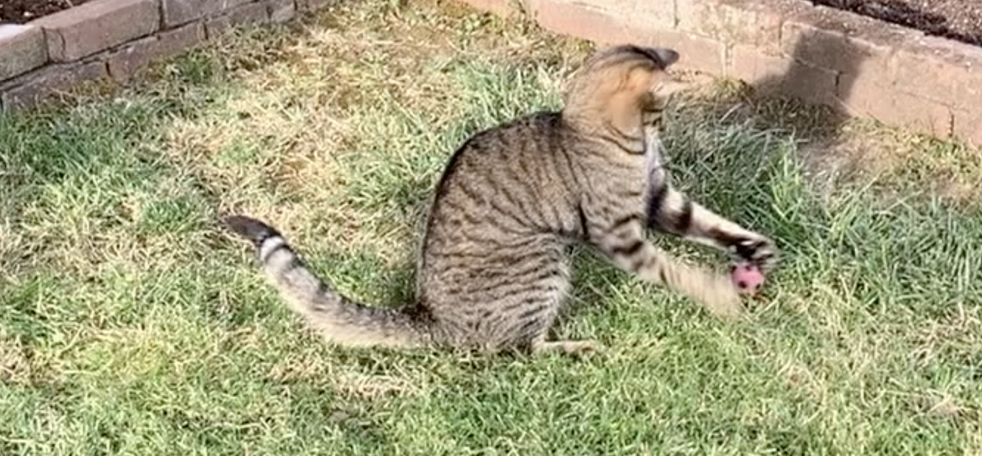
Bean has got the zoomies! Tossing balls to keep this energetic cat on the move!
Cats, although sometimes more aloof, also experience deep emotions. They may not show their affection in the same way as dogs. They have their own unique ways to express their feelings: These subtle cues help communicate a range of emotions, from happiness to stress:
- Facial Rubbing: Cats rub their face against you or objects to mark their territory, create a sense of comfort, and spread calming pheromones (natural chemicals that animals use to communicate). This behavior reinforces their bond with you and signals that they feel safe and secure in their environment.
- Purring: Cats often purr when they are content, relaxed, or feeling affectionate. However, they can also purr when they are stressed or unwell, using it as a self-soothing mechanism.
- Slow blinking: When a cat slowly blinks at you, it is a sign of trust and affection. This behavior is often referred to as a “cat kiss,” indicating that they feel safe and comfortable with you.
- Tail movements: A cat’s tail position can reveal its mood. A tail held high usually means confidence or happiness, while a puffed-up tail may indicate fear or aggression. A twitching tail can show irritation or excitement.
- Ears: Forward-facing ears typically show curiosity or interest, while flattened ears signal fear, stress, or anger.
- Kneading: When cats press their paws rhythmically into a surface (or person), it’s a sign of comfort and affection, often reminding them of the safety and warmth of their kittenhood.
- Hiding or withdrawing: Cats may hide or avoid interaction when they are scared, anxious, or feeling unwell. This behavior is a way for them to cope with stress or pain.
- Hissing or growling: These vocalizations are obvious signs of fear, anger, or frustration, often used as warnings to back off or give them space.
Interacting with your pet through play, exercise, training, or just relaxing, will bring out positive emotions and enhance your bond with your pet.
Ideal Routes for Your Furry Friend

Exploring the great outdoors with Sam. Hiking together strengthens your bond and keeps you both happy and healthy!
Are you looking for some spots to walk your pet?If you are looking for a nice and peaceful area to walk your pet, a cemetery might be an excellent choice because they are low traffic areas and peaceful. Here are some other ideas for more adventure:
- Rocky Glenn Park
- Bradley Park
- Benjamin-Doubet Park
- Jubilee State Park
- Rock Island Trail
- Wildlife Prairie Park
- Sommer Park
- Illinois River Bluff Trail
- Detweiler Park
Further out are Matthiessen State Park and Starved Rock.
Trouble with Your Pup in Public?How a Trainer Can Help
If you find yourself struggling with your pet’s behavior in public or social settings, enlisting the help of a professional trainer can be incredibly beneficial. A certified trainer can provide personalized guidance and effective strategies to address specific issues, helping your pet become more confident and well-behaved. With expert support, you and your dog can learn how to enjoy outings and have a more harmonious experience for you both you. There is also an excellent book, Training the Hard to Train Dog, that complements professional help.
Conclusion: Strengthening the Bond by Being Active with Your Pet
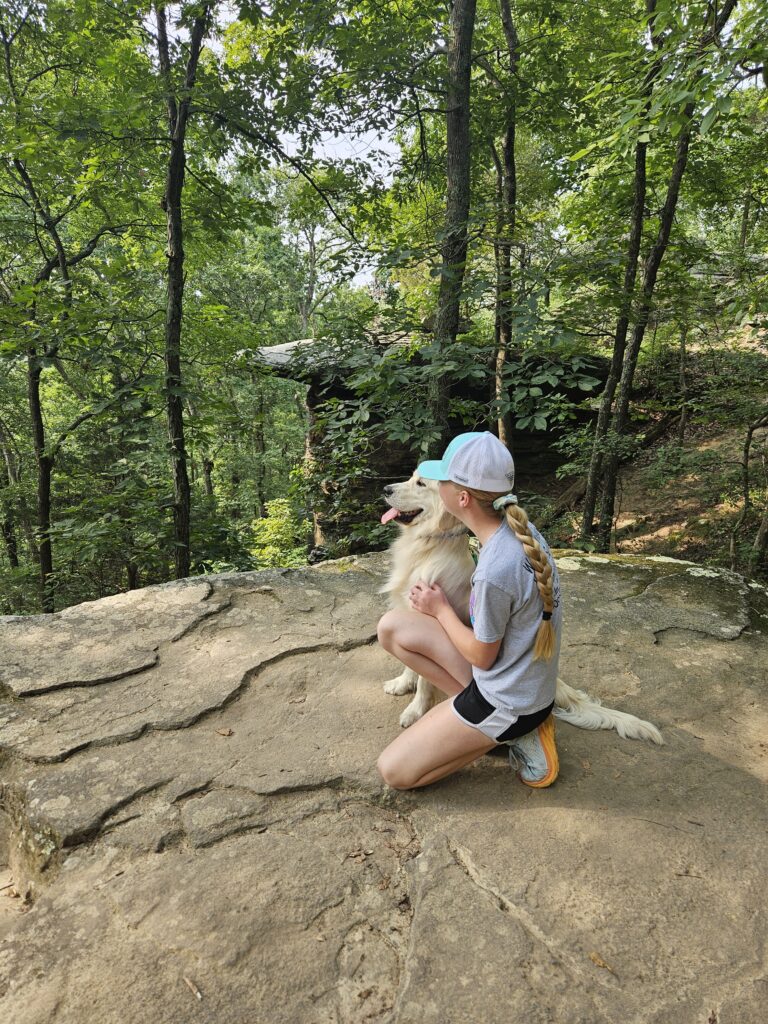
Staying active with your pet strengthens your bond and offers health benefits for both of you. Engaging in activities like walks or playtime not only enhances your pet’s well-being but also improves your own physical and mental health. These shared moments build trust, deepen your connection, and foster mutual loyalty. The love and companionship you receive in return make the investment in their well-being truly rewarding, enriching your life with a meaningful, lifelong relationship.
Ready to enhance your pet’s health and your bond? At Wags and Whiskers Veterinary Service, we are here to support you with expert care and advice for a happy, healthy pet. Whether you need tips on staying active together or professional training resources, our team is committed to your pet’s well-being. Contact us today to schedule a wellness check-up or to learn more about our services. Let us work together to ensure your furry friend thrives and you both enjoy every step of the journey!
Dr. Janelle McFarland & Team
